Was developed the e-skin, an electronic skin light and flexible for robots, to obtain more information about the environment.
Source: Engineering and Technology
A team from the University of Edinburgh said the skin can give robots a level of physical self-awareness similar to that of people and animals.
Soft robots – which are made of pliable materials rather than metal or hard plastic – with e-skin could have a range of applications, including surgical tools, prosthetics and devices to explore hazardous environments.
Unlike traditional rigid robots, soft robots are highly flexible which poses a major challenge to developing sensing systems that are essential for them to carry out precise tasks and interact safely with people and the environment.
The researchers said that without e-skin, it is difficult for soft robots to understand their own motion and shape, and how these qualities interact with their environment.
The flexible e-skin is made of a 1mm layer of silicone embedded with wires and sensitive detectors. Using it in combination with artificial intelligence, researchers were able to give soft robots the ability to rapidly sense their motions and deformations with millimetre-scale accuracy, in three dimensions, in real time.

The team tested their e-skin by fitting it to a soft robot arm and found that the technology was able to sense a range of complex bending, stretching and twisting movements across every part of the device.
Dr Yunjie Yang of the University of Edinburgh’s School of Engineering, who led the study, said: “The perceptive senses endowed to robotic devices by this new technology are similar to those of people and animals. This new level of physical self-awareness represents a step change in the sensing capabilities of soft robots.”
Study co-leader Dr Francesco Giorgio-Serchi, also of the School of Engineering, added: “The flexibility of the technology we have developed means it could be applied to various soft robots to enable them to accurately perceive their own shape and movements. Ultimately, that means we are now closer to making some of the most exciting ideas in soft robotics a reality.”
In December, Cornell University engineers created a soft robot capable of detecting when and where it was damaged and healing itself on the spot.
This robot from Cornell University was related on the site, the link to access the news.
Self-healing robot that detects damageClick here




